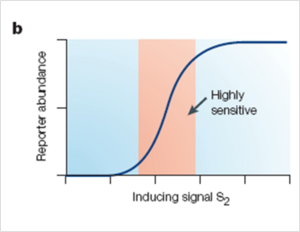Noise in Synthetic Cascades
HH McAdams and A Arkin characterized noise propagation in synthetic cascades. They detailed that stochasticity in gene cascades results from time delay in protein accumulation. More specifically, after the activation of a gene, to reach an effective level of control over the next gene requires time for protein signals (inducers and repressors) to accumulate. A threshold of protein control must be achieved in order for the successive protein to propagate its signal to the subsequent gene. Because proteins are produced in short bursts of variable numbers at random time intervals, there can be large discrepancies in the time between successive events in a regulatory cascade across a cell population (McAdams & Arkin, 1997).
This heterogeneity of protein expression among genetic cascades can result in a separation of the cell population into different phenotypes as the cells follow different expression pathways (e.g. cell differentiation).
Collins expressed that his colleague WJ Blake had engineered a transcriptional cascade composed of two regulatory steps. He found that increased noise in the transcriptional regulatory signal increased population heterogeneity very little at high or low levels of induction and was most sensitive during intermediate levels of induction. He commented that these data made sense in silico because transcription rate is most sensitive to variation in regulatory signal at intermediate levels. The figure below illustrates this point as reporter abundance curve has the highest slope at intermediate levels of induction. (Collins et. al., 2005)
Figure 1

Figure 1 was obtained at http://www.ncbi.nlm.nih.gov/sites/entrez?db=pubmed&uid=15883588&cmd=showdetailview&indexed=google permission pending
Figure 1 details protein abundance in response to an inducing signal